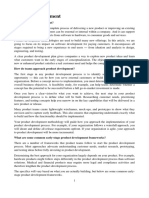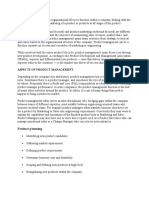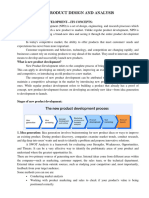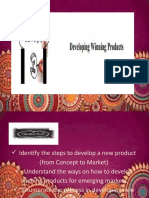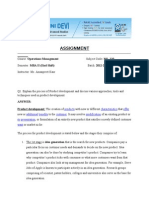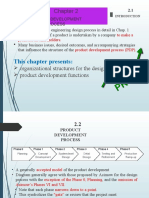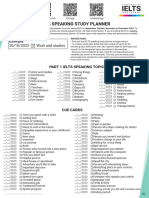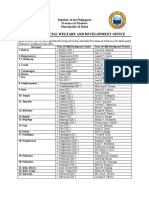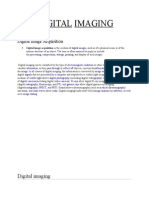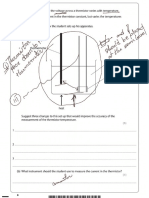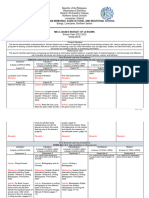Slide 5)
1. How does the process of product development work?
Creating a new product is both an exciting and difficult task. No two product launches are
the same, from concept through research and development. However, there is a common
procedure that might assist you in getting started with product creation. The product
development process outlines the six processes that must be followed to bring a product
from concept to market. This entails
• recognizing a market need,
• studying the competitors,
• coming up with a solution,
• creating a product roadmap,
• And constructing a minimal viable product (MVP).
The product development process has developed in recent years, and each stage is now
generally divided into six phases. This makes the process more organized and breaks down
specific deliverables into smaller jobs.
2. How the mission statement defines the development process?
The mission statement signals the start of the idea development process, which aims to
produce and choose product concepts that meet the stated application demands and,
eventually, product specifications. Concept development entails labor that is both creative
and analytical, as well as practical: Prototypes are used to convey product attributes and
functions, and concepts are developed, simulated, and contrasted. Prototypes may now
be made quicker and more efficiently using modern computer-aided engineering tools
and production technologies such as 3D printing, and then used throughout the whole
product development process.
3. What exactly is idea development, and what does it entail?
The process of producing ideas to tackle specific design challenges is known as concept
development. The concepts are created in stages, from a vague notion to a specific
statement with accompanying images and material. You're ready to start working on the
actual design once you've done your research and know exactly what you want to achieve
and why. In an ideal world, you'd create a concept that solves the design challenge,
communicates successfully on several levels, is original (different and interesting), and
sticks out among your client's rivals' materials.
Slide 6)
Classic product development approaches are primarily concerned with the development stage
and the beginning of the introduction stage. Modern product development philosophies and
approaches consider the complete lifecycle, with the aim of decreasing the total cost of
ownership, increasing the revenue of servitization (in the case of product service systems), and
guaranteeing the sustainability of the product (Pessôa & Trabasso, 2017). By considering the
complete lifecycle, the product development process can account for all issues the product will
face. The value that users and customers seek from a product is affected by market changes that
1|Page
�can be unpredictable; therefore, modern product development approaches try to design from
the start a product which can evolve accordingly, minimizing the time and money needed in the
future for redesign, improvement, and phasing out. This approach, however, requires a larger
monetary investment in the preliminary phases of the product’s development. The process steps
from product planning to production ramp up (beginning of the introduction stage) and comprise
the core of the generic product development process (Ulrich & Eppinger, 2016).
Production ramp-up
This is the final phase of product development, when the new product moves from pilot
production and prototypes to full-scale manufacturing. The process is an excellent way to reflect
on each step of a product’s development and focus on the priorities of each phase.
The process adapts to the main product development scenarios, namely the development of a
new product, product modification, or product addition. Based on the specific case, emphasis is
put on different phases. For instance, the development of a new product requires the devotion
of lots of time to a careful, in-depth identification of user opportunities and very strategic
planning. In addition, the market (which is typically unknown) needs considerable exploration,
and meaningful connections to users and customers must be slowly built. In the case of a product
modification, development begins with an experience and knowledge base concerning the target
users.
Slide 7)
Identification of market opportunities, which is a precondition for planning, starts with the
creation of an unordered list of possible product ideas, including product modifications,
additions, or innovations. Each opportunity is briefly described in terms of the main product
vision and functionality. The next phase—the planning—focuses on the following goals:
• identifying the opportunities to pursue and develop into products;
2|Page
�• sketching a development plan with a particular focus on timing; and
• allocating resources for the development.
Slide 8)
Usually, the planning phase is continuously refined based on the latest information gleaned from
the development. Even when the initial planning is completed, the product is still just an idea.
The planning process suggested by Ulrich and Eppinger (2012) consists of three main steps:
1. Evaluate and prioritize projects
2. Allocate resources and plan timing
3. Complete pre-project planning
Slide 9)
The first step is to evaluate the collected opportunities from the perspective of the company.
Two development scenarios can be identified: the development for existing markets and
existing product categories, which includes new product platforms, derivatives of existing
platforms, or product additions and modifications; or the development of fundamentally new
products, which may address new markets and create new product categories for the company.
Four evaluation perspectives are useful for the first development scenario (existing
markets/product categories). Opportunities should be initially screened based on the
competitive strategy of the company.
Primary strategy, the focus will be on ideas for improving the production process for existing
products in terms of efficiency, costs, ease of maintenance, and robustness. Another strategy is
imitation: in this case the company prefers to produce me-too products in a very efficient and
timely way. Other companies pursue technological leadership, meaning they actively support and
invest in research and development in order to be prepared for technological breakthroughs. The
choice of the main strategy influences the evaluation of the opportunities. For example, an
imitative company will probably discard an opportunity requiring huge technological effort
(Ulrich & Eppinger, 2016).
Competitive strategy
The competitive strategy of a company is its long term plan to gain competitive advantage in the
market.
Market segmentation
This is the process of dividing potential customers into segments based on different
characteristics.
3|Page
�Slide 10)
The use of a new technology in a product line is also an important decision which can be made
based on technological trajectories. These are represented by curves showing the status of a
given technology, helping to predict whether a certain technology will offer a competitive
advantage in the near future. The trajectories are similar to the S-curves of the product lifecycle
in that they represent a technology lifecycle. One example is the adoption of digital image
acquisition and processing in modern reflex cameras. At the beginning of the 2000s many
suppliers switched from analog, film-based technology (in its decline stage) to digital-based. Such
predictions about technology are still risky, though, because the S-curves are not known a priori
(Ulrich & Eppinger, 2016).
The fourth important perspective is that of product platform planning. A product platform is the
“set of assets shared across a set of products” (Ulrich & Eppinger, 2016). The development of a
product platform is risky, especially in terms of the huge costs and time investment. The
advantage is that, once the platform is ready, a variety of derivative products can be produced
faster and at less cost, meaning various market needs can be easily addressed through careful
customization. If some opportunities are able to fit on the same platform, one strategic planning
decision would be to develop the platform and then derive the products. Since platform
development is closely related to certain technological developments, state-of-the-art
technology must be monitored and analyzed. One option for doing this is using a technology
roadmap (Ulrich & Eppinger, 2016). This road map places different current technologies on a
timeline to assist with the decision of which one to use for the platform development.
Slide 12)
Another useful diagram is the product-process change matrix. Here, the x-axis represents the extent of
would-be change in the product, and the y-axis represents the extent of would-be change in the
production process. This perspective is interesting to have for balancing a portfolio, i.e., ensuring that the
products put into development fulfill the company’s strategy.
4|Page
�Slide 13)
Technical innovation (describes the application of technical knowledge in new or improved
products or production processes);
• Service innovation (the application of new service ideas in the market);
• Marketing innovation (improves communication and/or transactions with customers);
• Business model innovation (a change in the business model to improve customer/ user
satisfaction or a change in a company’s role in the product value chain);
• Design innovation (refers to changes in the usability and/or aesthetic quality of a product
in order to improve customer experience); and
• Social innovation (describes the introduction of new social practices, e.g., new ways of
communication and cooperation in a society).
The planning considers time explicitly. Time is an important factor for the success of a product.
For example, for product additions or incremental improvements which respond to a market
need, the time to market is a critical factor for success. The preliminary time and resource (i.e.,
budget) constraints put on the product’s development in the planning phase sets a development
project for the product, ultimately yielding a product plan.
Slide 14)
5|Page
�The planning is complete once a mission statement for each product to be developed is provided. Each
mission statement corresponds to a preliminary, defined development project. The mission statement,
also called design brief or product charter, collects the following information (Ulrich & Eppinger, 2016):
• Brief description of the product and its functionality
• Benefit proposition stating why the product is expected to be advantageous
• Key business goals including time, cost, quality goals, and desired market goals
• The primary market
• Secondary markets
• Assumptions and constraints, e.g., which technology should be used, which kind of product
development, how the manufacturing will be carried out
• The stakeholders
Slide 17)
User needs are expressed informally (“in the language of the customer” (Ulrich & Eppinger,
2016)), and they must be successively translated in preliminary target specifications for the
technical development to start. Without precise technical specifications, there is no way to
determine the best product concept(s).
Slide 18)
Product concept
A product concept is an approximate description of the technology, working principles, and form
of the product.
Functional decomposition
The functional decomposition decomposes a functional relationship into the composing parts.
6|Page
�Slide 20)
One qualitative method is the concept screening matrix. This method requires either choosing a
reference concept among the concepts pool or considering a commercial and/or standard
solution as the reference concept. A matrix is then built with selection criteria (related to user
needs) in the rows and the concepts in the columns. Each concept is evaluated with respect to
each criterion and the reference concept. The evaluation uses a “+” to indicate that the concept
performs better than the reference or a “–” to indicate that the concept performs worse than
the reference. A “0” is used to indicate that the concept performs as well as the reference. Of
course, the reference concept scores “0” for each criterion. The concepts are evaluated by
summing the number of “+”s, “–”s, and “0”s and identifying the concepts which score the best.
The criteria should include relevant metrics for the company which have an indirect impact on
users, for example, manufacturing cost or ease of manufacturing and assembly. Such metrics are
never expressed as user needs but are nonetheless important for all product stakeholders.
7|Page
�Slide 21)
Concept Testing
The few promising concepts that result from the concept selection phase should be tested.
Concept testing is concurrent to concept selection with the main difference that the testing is
carried out together with the users and customers. The influence of the development team on
the selection of concepts based on testing results is minimal. In fact, the purpose of concept
testing is to solicit a response to a description of the product concept from potential customers
in the target market (Ulrich & Eppinger, 2016).
Concept testing is performed at various points in the product development process. It can be
performed at the beginning, together with the identification of market opportunities and product
planning, or during the concept development phase. In both cases, the testing is mainly
qualitative. Quantitative testing is done later in the testing and refinement phase, which succeeds
the design phase and precedes the production ramp-up. The main goals of the testing at different
stages are to:
• understand the market that the product is to address;
• select from alternative concepts and designs;
• confirm concept selection and design decisions;
• forecast the market demand (e.g., how many units should the company be ready to produce?);
• benchmark the product; and
• find further areas for improvement based on user reactions (Ulrich & Eppinger, 2016).
Testing can be carried out in different ways, for instance by means of customer surveys and
customer interaction with early prototypes.
Slide 22)
A cost model predicts the cost performance of a concept when given a combination of design
variables. An accurate prediction can be difficult in the earlier stages of product development.
However, the team can
• break the concept into elementary parts;
• estimate upper and lower bounds of the cost for each part, meaning the cost of manufacturing
or purchasing;
• estimate the overall cost of the concept by summing each partial cost (worst case, best case, or
average case).
8|Page

